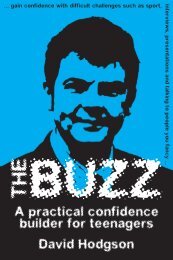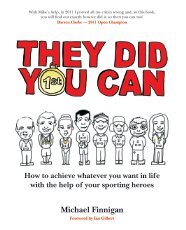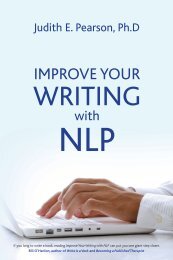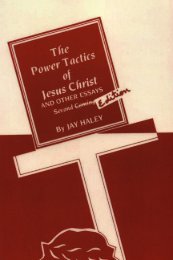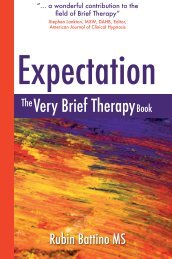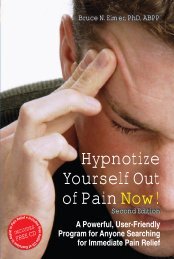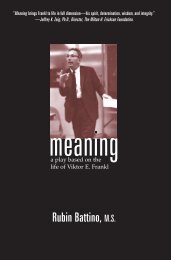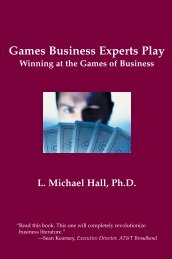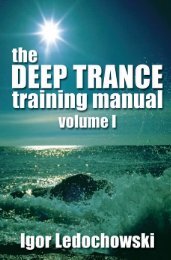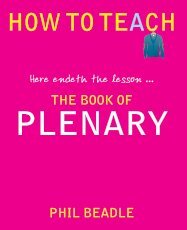Learner’s Toolkit
Look Inside - Crown House Publishing.
Look Inside - Crown House Publishing.
- No tags were found...
You also want an ePaper? Increase the reach of your titles
YUMPU automatically turns print PDFs into web optimized ePapers that Google loves.
The<strong>Learner’s</strong><strong>Toolkit</strong>Supporting theSEAL Framework forSecondary Schools• Developing EmotionalIntelligence• Instilling Values for Life• Creating IndependentLearnersJackie BeereEdited by Ian GilbertIncludes a Free CD-ROM
The<strong>Learner’s</strong><strong>Toolkit</strong>Supporting theSEAL Framework forSecondary Schools• Developing EmotionalIntelligence• Instilling Values for Life• Creating IndependentLearnersJackie BeereEdited by Ian GilbertCrown House Publishing Limitedwww.crownhouse.co.ukwww.chpus.com
First published byCrown House Publishing LtdCrown Buildings, Bancyfelin, Carmarthen, Wales SA33 5ND, UKwww.crownhouse.co.ukandCrown House Publishing Company LLC6 Trowbridge Drive, Suite 5, Bethel, CT 06801, USAwww.chpus.com© Jackie Beere 2007Illustrations © Les Evans 2007The right of Jackie Beere to be identified as the author of this work has been asserted by her inaccordance with the Copyright, Designs and Patents Act 1988.All rights reserved. The purchase of this book entitles the individual teacher to photocopy thelesson worksheets or print them from the files on the CD-Rom in the back of this book for use inthe classroom. The reproduction of any part for an entire school or school system or forcommercial use is strictly prohibited. Except as permitted under current legislation, no part of thiswork may be stored in a retrieval system, published, performed in public, adapted, broadcast,transmitted, recorded or reproduced in any form or by any means, without the prior permissionof the copyright owner. Enquiries should be addressed to Crown House Publishing Limited.British Library of Cataloguing-in-Publication DataA catalogue entry for this book is available from the British Library.13-digit ISBN 978-18490070-010-digit ISBN 1845900707LCCN 2007925537The author and publisher gratefully acknowledge the permission granted to reproduce thecopyright material in this book.Every effort has been made to trace copyright holders and to obtain their permission for the use ofcopyright material. The publisher apologises for any errors or omissions and would be grateful ifnotified of any corrections that should be incorporated in future reprints or editions of this book.The 8Way Thinking Tool (page 58) has been reproduced with the permission of IndependentThinking Ltd.‘The Tyger’ by William Blake has been reproduced with the permission of Harper Collins.Edited by Ian GilbertTypeset by 4word, BristolPrinted and bound in the UK by Cromwell Press, Trowbridge, Wiltshire
ContentsForeword by Ian GilbertvIntroductionixSection 1: The Habits of Emotional Intelligence 1Lesson 1: Understanding Emotional Intelligence (EQ) 4Lesson 2: Test your EQ 8Lesson 3: Get to know your best friend – YOU 12Lesson 4: It’s MY life 16Lesson 5: Goals for life 20Lesson 6: Build your confidence 24Lesson 7: Be your own life coach 28Lesson 8: Mind Power 32Lesson 9: Persistence and Resilience 36Lesson 10: Mood Control 38Lesson 11: Optimism 42Lesson 12: Taking care of mind and body 46Lesson 13: Stress Management 50Lesson 14: Thinking skills 54Lesson 15: Asking the right questions 56Lesson 16: Mastering your memory 60Lesson 17: Train your brain to wait 64Lesson 18: Having courage to think in other ways – Thinking hats 68Lesson 19: Grow your confidence and courage 70Lesson 20: Courage – be brave 74Lesson 21: Empathy – put yourself in other’s shoes 78Lesson 22: Communicate and co-operate for success 80Lesson 23: Prioritise and plan 84Lesson 24: Review the habits of EQ 88Lesson 25: What have you learnt about EQ? 90iii
Section 2: Lessons in Learning to Learn 93Amazing Brains 95Lesson 26: Understanding your amazing brain 96Lesson 27: Your P.E.T. brain 98Lesson 28: Your Emotional Brain 102Lesson 29: The Thinking Brain 104Lesson 30: Brain Boosters 108Multisensory Learning 111Lesson 31: See Sense. How to use your senses for learning 112Lesson 32: Be a powerful visual learner 116Lesson 33: Using your inner eye 120Lesson 34: Improve literacy through visualisation 124Lesson 35: The best learners are listeners! 128Lesson 36: Kinesthetic Learning 132Multiple Intelligences 135Lesson 37: How can I be a genius? 136Lesson 38: How am I smart? 140Lesson 39: Using all your intelligences 144Lesson 40: Learning in different ways 146Lesson 41: Challenging your brain to use the Smarts 148Section 3: Values for success in life 151Lesson 42: What are the values for success in life? 152Lesson 43: V is for Vote for democracy and equality 156Lesson 44: A is for Attitude is everything 160Lesson 45: L is for Love is all you need 164Lesson 46: U is for Understanding that family and friends matter! 168Lesson 47: E is for Enterprise and Energy 172Lesson 48: S is for Social intelligence 174Lesson 49: L is for Laughter and fun 178Lesson 50: I is for I can choose 182Lesson 51: F is for Forgiveness and Fairness 186Lesson 52: E is for Earn respect through Empathy 190contentsivGlossary 193Bibliography 197Index 199
IntroductionThe secondary SEAL resources, are to be launched nationally in September … it catches a tide of separatewaves in education, including circle time, emotional literacy, anger management, behaviour improvementand monitoring of learning … schools welcome official blessings to concentrate on what they have alwaysconsidered to be the core values – co-operation, self esteen and consideration for others … and learning!Gerald Haigh, TES, 1st June 2007The <strong>Learner’s</strong> <strong>Toolkit</strong> is a comprehensive setof resources that will help teachers implementthe SEAL (Social and Emotional aspects ofLearning) programme recommended by theNational Strategy. It is divided into threesections: Emotional Intelligence, Learning toLearn and Values for Life. These sectionstarget the aims of QCA’s 21st centurycurriculum for Successful Learners, ConfidentIndividuals and Responsible Citizens.The lessons in this toolkit will providedetailed plans that enable schools to transformlearning and raise standards throughimpacting on personal and emotionaldevelopment. In addition, this toolkit createsresources to develop the crucial habits anddispositions stated in the Ofsted 2020 visiondocument which include:■ taking responsibility for, and being able tomanage one’s own learning and developingthe habits of effective learning■ knowing how to work independently withoutclose supervision■ being confident and able to investigateproblems and find solutions■ being resilient in the face of difficulties■ being creative, inventive, enterprising andentrepreneurial.Ofsted Vision 2020, 2007National Strategy Programmefor Social and EmotionalIntelligence (SEAL)QCA 21st century curriculumSuccessful LearnersConfident IndividualsResponsible CitizensOfsted 2020Vision forTeaching and Learningix
The three sections overlap in many aspectsand reinforce each other in many ways.There are more than 50 lessons written to lastup to one hour and each lesson has a full set ofteacher’s notes with guidance on how todeliver the lesson. Pages can be copied andshared with students.L2L – all aboutthe brain andhow to use itEQ – essentiallessons in how tomanage your mindand emotionsValues – lessonsthat reinforcepersonal valuesThis toolkit can be used for PSHE lessons,Citizenship lessons, Learning to Learnlessons, or as part of a competency basedcurriculum. It can be used across KS3 andinto KS4 or KS2. The lessons are planned todevelop important competencies that manyemployers say are vital for success at work andat home. These competencies include:These themes are linked to QCAaims for successful learners,confident individuals andresponsible citizens.The competenciesCommunication andcollaborationTeaching strategiesEncourage group work, team building and leadership skills.Formal and informal speaking and presentations, as well as highquality writing outcomes.introductionxLearning to learnInvestigation and enquiryCreativity and enterpriseSelf-managementFocus on how we are learning. Use a language for describinglearning styles and preferences.Asking high level questions and students learning to ask highlevel questions. Focus on enquiry based learning.Trying out ideas, developing own content and independentlearning. Encourage taking risks and learning through mistakes.Managing their own learning, working to dealines and takingresponsibility for outcomes. Using self and peer assessmentstrategies to develop self awareness and confidence.
Using this book to deliver acompetency based curriculumEach lesson provides strategies for developingcompetencies and dispositions that are crucialto independent learning. Students should beencouraged to self assess in order to developtheir skills and there are two grids that mayhelp with this. The grids create a frameworkfor assessing progress and a picture of whatstudents are working towards. We need to beable to answer the question, ‘What does goodprogress look like and how do we know whenwe have improved?’Assessment Tool 1This grid helps locate lessons related to aparticular competency. The competenciesshown are adapted from the Royal Society ofArts competencies and should be seen as justone possible set. You may wish to use all orsome of these competencies, but schoolsshould choose their own set that suits theircontext.Students may wish to assess themselvesagainst some of these criteria when they havecompleted lessons or they may wish to addalternative statements to the grid. It should beused as a flexible live document that monitorsprogress and learning.Competency Section 1 – EQ Section 2 – L2L Section 3 – ValuesCommunication and 1, 2, 3, 4, 6, 7, 13, 25, 32, 34, 40 43, 44, 45, 46, 48,collaboration 14, 20, 21, 49, 50, 51, 52Learning to learn 2, 3, 6, 8, 10, 13, 15, 24–41(all) 47, 5016, 17, 18, 21Investigation and 13, 14, 15, 16, 17, 27, 28, 30, 31, 32, 33, 42, 43, 50enquiry 18, 21 37, 38Creativity and 5, 6, 7, 10, 13, 14, 24, 25, 26, 30, 36, 37, 44, 47, 48, 50enterprise 16, 18 40, 41Self management 1–23 (all) 24–41(all) 44, 45, 46, 48, 50, 52CLICrS – Competency assessment formCommunicationandcollaborationLearning tolearnInvestigationand inquiryCreativity andenterpriseSelf management/emotionalintelligenceLEVEL 1Reluctant tocommunicatebeyondimmediate peers.Find effectivegroup workchallenging.Not aware oflearning styleand how todevelop it.Finds traditionallearning difficult.Fails to engagewith tasks.Seeks immediategratification.Accepts sourceswithoutquestion.Needs support toask the rightquestions.Findssummarisingideas difficult.Needsprompting totake initiative.Finds creatingideaschallenging.Lacks selfawareness.Disorganised.Fails to takepersonalresponsibility foroutcomes.xi
CLICrS – Competency assessment formCommunicationandcollaborationLearning tolearnInvestigationand inquiryCreativity andenterpriseSelf management/emotionalintelligenceLEVEL 2Can take part ingroup work andis developingleadership skills.Cancommunicateorally and inwriting at asatisfactory level.Has level ofempathy andrespect forothers.Knows learningprofile.Is interested inlearning.Needs somesupport butwill workindependently.Is developingstrategies totransfer skillsfrom one contextto another.Asks questionswhen prompted.Can summarisean argument andpick out theimportantpoints.Willing to tryout new ideas.Will tacklechallenges withsupport.Within groupwill createsolutions.Learns frommistakes.High selfesteem.Confident selfbelief.Well organisedand effective.Manages anxietyand challengesvery well.introductionLEVEL 3An excellentleader orparticipator.Excellentcommunicationskills, orally inwriting andmultimedia.Can gain rapportwith peers orothers quicklyand effectively.Demonstratesand sustainsrespect andempathy to ahigh level.Understandslearning stylesand iscontinuouslylearning.Has flexibleapproaches tolearning.Can learnindependentlyand coachothers.Can transferskills from onecontext toanother.Is comfortablewith makingmistakes andlearning fromexperience.Can interrogateresources andsummarisemessages.Can questionvery effectively.Can complete acritique on aproposal orproject.Is capable ofthinking ofhighly creativesolutions.Can takeinitiative andtackle challengeswith flair andoriginality.Is open to newideas andexperiences.Organises timeand resourceshighlyeffectively.High level ofself esteem andintrapersonalintelligence.High level of selfawareness.Can manageanxiety andstress effectively.Can motivatethemselves andothers.Has ambitiousgoals.Can gainexcellent rapportwith a variety ofaudiences.xii
Assessment Tool 2This assessment tool helps to identify somelevels of working that demonstrate effectivelearning. It is not definitive and ‘mastery’encompasses a wide spectrum of ambitions forlearning that will continue for life. ‘Mastery’of learning is a condition we aim for andcontinually work towards. If students canunderstand what it is they are aiming for, it ismore likely they will see the point of thelessons and make a connection with the aimsof the lessons.This audit can be used in lesson observations(by teachers and students) to see whichbehaviours are demonstrated. It can also beused in target setting meetings with studentswhen they can discuss where they fit into thelevels of competence. The aim will be that asstudents move through the programme, theyachieve ever higher levels of competence.Student Learning to Learn AuditTypical traitsWorking towards(developing)Working at(competent)Working beyond(mastery)Confident individuals(EQ)CommunicationSelf beliefSelf awarenessSelf managementInterpersonal skillsOvercoming low selfesteem.Increasing selfawareness regardingskills and abilities.Effectively organisingtime and resources.Working effectivelywith others.Able to learn frommistakes with support.Aware of abilities andskills and able to usethem most of the time.Can organise time tocomplete most tasks todeadline.Communicates wellwith peers.Can concentrate andapply themselves to …Willing to try out ideasand hypothesise.Uses resources well.Learns from mistakes.High self esteem.Confident self belief.Well organised andeffective.Manages anxiety andchallenges very well.Can gain excellentrapport with a varietyof audiences.Sustainedconcentration andcommitment.Enthusiastic andenergetic.Adaptable and flexible.xiii
LESSON 21Empathy – put yourself inother’s shoesHabit 9: Co-operate and communicateTipThe starter is to consider how easy it is to geton with friends. However, it is moredemanding but just as important to get onwith others. Becoming adaptable and flexibleas a communicator is an importantcompetence.Students love to make the glasses but theytake a long time and distract them from thepurpose of the lesson.Talking for one minute on each of thestatements with and without empathy glassesworks well.ResourcesCard and scissors to make empathy glasses.If time is short, make the glasses in advanceand give them out.The discussion how to improve empathycould well be enhanced by reference to thesociety without empathy, what would it belike and so on.Some of the role-plays can be shown toothers.AimThe last task is important for transference ofskills and ideas into the main curriculum.teacher’s notesThe aim is to use a practical device – theempathy glasses – to be able to see situationsin a different perspective.ReviewBy the end of this lesson students will know So what was empathy again?how important and difficult it is to try to seethings from other people’s viewpoint.The meaning of your communication isClass discussion on empathy.the response you get.Empathy glasses can become a way tounderstand how to see things from another’sviewpoint.78 Section 1 • The Habits of Emotional Intelligence
Lesson 21EmpathyPut yourself in other’sshoesHabit 9:Co-operate and communicateEmpathy is an important part of EQ.Getting on with others is interpersonal intelligence.How good are you at working with others?Having empathy will create good relationships.How well do you get on with: 10/10 is highYour friends (easy) /10Your sisters and brothers (harder) /10Your mum and dad/carers (can be hard) /10Your teachers (very hard) /10Your neighbours (harder still) /10People you don’t know yet (hardest) /10If you are a good communicator you will get onwell with others – including people you don’tknow. In life there will be many occasions whenyou need to communicate with people you don’tknow. Most people who are successful knowhow to put themselves in other people’s shoes.They are good listeners and can makethemselves understood.Make a pair of empathy glasses from card and put them on when you needto make a conscious decision to see another person’s viewpoint.In pairs, choose one of these statements and give your opinion about it inone minute:● Students should be paid to go to school.● Parents should be allowed to smack their children.● Bullies should be forgiven.● There should be no homework for children.● Drugs should be legalised.Now argue the opposite view to each otherwith your empathy glasses on. Score yourempathy factor for each other out of ten.Role-plays are a good way of improvingcommunication and empathy.Neighbourhood nightmare. Play roles of an oldpensioner, young vandals, the village policeman,the school caretaker and so on. Each gives astatement about trouble that has been going onin the village. Swap roles.The <strong>Learner’s</strong> <strong>Toolkit</strong> © Jackie Beere and Crown House Publishing Ltd 79
LESSON 34Improve literacy throughvisualisationAimMuch research has been done in the USA(notably by Lindamood–Bell, www.lblp.com)on the correlation between a failure to createvisual images and restricted comprehensionskills. This lesson helps students use imagingto understand text.For the Shakespeare piece students can talkthrough or draw images that come to mindwith each line to help them learn what itmeans and possibly learn it off by heart.Experiment with other texts.(Please pass on this technique to your LiteracyCo-ordinator because it could really helpstudents improve their reading skills.)First thoughtsTeachers should get students to recallmemories of holidays and describe them insome detail to start to locate the visualmemory.‘Man’s mind cannot understand thoughtswithout images of them’.Thomas AquinasPlanteacher’s notesFirst read out the passage and then studentscan produce the images in the boxes for eachsection. It really doesn’t matter whether theyuse pictures, colours or words in each box aslong as they are focusing on the images. It ismuch better if they talk about what they areseeing and describe it in detail.124 Section 2 • Lessons in Learning to Learn
Lesson 34Improve literacy throughvisualisationTurn movies on in yourhead when you read‘Man’s mind cannot understand thoughts without imagesof them’ Thomas AquinasVisualising for comprehensionIf you can make pictures in your mind it can help youunderstand what you read and this will help you inexams.Read this passage from ‘Unforgettable places tosee before you die’ by Steve Davey.1. As you stand in the cold darkness of an Arizona night, waiting for dawn,you will have no comprehension of the enormity of the landscape infront of you. In the dull early light your first view of the Grand Canyonwill be a flat, almost painterly composition.2. Then gradually the sky turns to blue and red, and golden sunlight startsto pick out details – first the edge of the far ridge, then the tallestpinnacles inside the canyon itself.3. As the sun rises higher, more is revealed. Rock formations sculpted byyears of erosion are illuminated, and long, convoluted shadows are caston to giant screens formed by cliffs.4. Only when you notice the details, such as a row of trees, or a flock ofgeese flying overhead, do you come to realise the true scale of thecanyon. That far ridge might be 15km away, and the mighty ColoradoRiver – a mere stream viewed from above – is 1500 metres below.The <strong>Learner’s</strong> <strong>Toolkit</strong> © Jackie Beere and Crown House Publishing Ltd 125
Lesson 34 – continuedImprove literacy throughvisualisationFor each section 1–4Create a picture in your head.In each box either write words or draw picturesor stick men to show what is in these pictures.Add extra details that make it more interestingbut still fits with the text.Describe in words what is in each picture to yourneighbour.1 23 4126 The <strong>Learner’s</strong> <strong>Toolkit</strong> © Jackie Beere and Crown House Publishing Ltd
Lesson 34 – continuedImprove literacy throughvisualisationTest how this has improved your memory andunderstanding by describing what is in thepassage below.1Make it into a film.Making visual images can help you understandand remember poetry.Create a picture for each section of this famousspeech in Shakespeare’s ‘Macbeth’.1. ‘Tomorrow and tomorrow and tomorrowCreeps in this petty pace from day to dayTo the last syllable of recorded time22. And all our yesterdays have lighted fools theway to dusty death. Out, out brief candle!Life’s but a walking shadow, a poor playerThat struts and frets his hour upon the stageAnd then is heard no more;3. It is a taleTold by an idiot, full of sound and furySignifying nothing’Describe to your neighbour what is in eachpicture and why.3See how much of the poem and its meaning youcan now remember.The more you practisevisualising and talking aboutthose pictures the easier youwill find it to remember thingsand understand meanings.The <strong>Learner’s</strong> <strong>Toolkit</strong> © Jackie Beere and Crown House Publishing Ltd 127
The <strong>Learner’s</strong> <strong>Toolkit</strong> is an essential resource for supporting the SEAL framework in secondaryschools and for all those teaching 11-16 year olds. It contains everything you need to create trulyindependent learners, confident and resilient in their ability to learn and learn well. The bookcontains 50 lessons to teach 50 competencies. Each has teacher’s notes on leading the lesson anda CD-ROM in the back of the book has all the student forms and worksheets necessary for thelessons. Lessons include:n getting to know yourselfn taking responsibility for your own lifen persistence and resiliencen setting goals for lifen controlling moodsn caring for your mind and bodyn building brain powern asking questionsn developing willpowern pushing yourself out of your comfort zonen prioritising and planningPossessing these vital competencies will help students learn better and be able to contributemore effectively in school. It will also enable them to thrive in the increasingly fast-paced world ofthe 21st Century.“This book supports the new Secondary Curriculum in its efforts to promote Personal Developmentand links diversity to the Social Emotional Aspects of Learning (SEAL) Framework for secondaryschools. It gives teachers starting points, plans and examples to help them use their own ideasto support the progress of young people in the most vital of all areas of learning ... how to copewith and contribute to the world in which they find themselves.”Mick Waters, Director of Curriculum, QCA“Jackie Beere has produced a powerful and extensive resource for all of us who want learners tobecome independent, self-aware, socially skilled and responsible. Surely these qualities are thenew, broader ‘standards’ that the nation is now realising matter over and above examinationresults.” Paul Ginnis, Trainer and bestselling author of The Teacher’s <strong>Toolkit</strong>“Developed and honed in the cut and thrust of real classrooms, it directly supports the SEALprogramme by addressing three core areas – “Emotional Intelligence”, “Learning to Learn” and“Values for Life”. It’s not, though, just a “how to” book for teachers – though that aspect iscertainly there. What’s especially valuable is the wealth of classroom material that’s provided –detailed lessons, with resources that children will find interesting and challenging. You’ve heardall the rhetoric about emotional intelligence, and the need to create confident learners. Nowhere’s a resource that will help you to do something about it, right now, in your classroom.”Gerald Haigh, former Headteacher, writer and consultant forthe Times Education Supplement and other educational publicationsJackie Beere is a consultant trainer and School Improvement partner, having been headteacherat Campion School, Northants. She spent three years as an Advanced Skills Teacher leading andimplementing innovative Teaching and Learning initiatives including KS3 and 4 Learning to Learnand Thinking Skills programmes. In November 2002 Jackie was awarded the OBE for her servicesto education.The Competency Curriculum <strong>Toolkit</strong>Developing the PLTS Framework ThroughThemed LearningJackie Beere and Helen BoyleISBN 978-184590126-4The Primary <strong>Learner’s</strong> <strong>Toolkit</strong>Implementing a creative curriculum throughCross Curricular Projects: Developing social andemotional intelligence: Creating independent,confident and lifelong learnersJackie Beere Edited by Ian GilbertISBN 978-184590395-4The Independent Thinking Series brings together some of the mostinnovative practitioners working in education today under theguidance of Ian Gilbert, founder of Independent Thinking Ltd.www.independentthinking.co.ukISBN 978-184590070-09 0 0 0 0Crown House Publishing Limitedwww.crownhouse.co.uk — www.crownhousepublishing.comIllustration Les Evans9 781 845 900700



